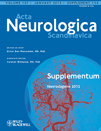
Annals of Indian Academy of Neurology
Scope & Guideline
Bridging Knowledge Gaps in Indian Neurology
Introduction
Aims and Scopes
- Neurological Disorders Research:
The journal covers a comprehensive range of neurological disorders, including but not limited to Parkinson's disease, stroke, epilepsy, and neurodegenerative diseases. It emphasizes both clinical and experimental research to enhance understanding and treatment. - Clinical Trials and Interventions:
A significant portion of the journal's publications focuses on clinical trials assessing the efficacy and safety of various therapeutic interventions, including pharmacological treatments, surgical procedures, and alternative therapies. - Epidemiology and Public Health:
The journal addresses the epidemiological aspects of neurological disorders, particularly in the Indian context, exploring risk factors, prevalence, and the impact of socio-economic factors on neurological health. - Neurogenetics and Biomarkers:
There is a growing emphasis on genetic studies and the identification of biomarkers that can aid in the early diagnosis and treatment of neurological conditions, reflecting the trend towards precision medicine in neurology. - Innovative Diagnostic Techniques:
The journal promotes the use of advanced diagnostic methodologies, including neuroimaging techniques and electrophysiological assessments, to improve diagnostic accuracy and patient outcomes. - Neurorehabilitation and Quality of Life:
Research on rehabilitation strategies and their effects on quality of life for patients with neurological disorders is a key focus, highlighting the importance of comprehensive care beyond pharmacological treatment.
Trending and Emerging
- COVID-19 Neurological Complications:
A significant increase in research addressing the neurological effects of COVID-19 has been observed, including studies on post-viral syndromes and neurological manifestations associated with the infection. - Telemedicine in Neurology:
The pandemic has accelerated the adoption of telemedicine in neurology, leading to a surge in research on its effectiveness, challenges, and potential for enhancing patient care. - Neuroimmunology and Autoimmune Disorders:
There is a growing emphasis on neuroimmunological disorders, particularly autoimmune encephalitis and related conditions, reflecting increased awareness and advancements in diagnostic techniques. - Neurodegenerative Diseases and Biomarker Research:
Research on neurodegenerative diseases, particularly the identification of new biomarkers for early diagnosis and monitoring of conditions like Alzheimer's and Parkinson's diseases, has gained momentum. - Mental Health and Neurology:
An emerging focus on the intersection of mental health and neurological disorders is evident, with studies exploring the psychological impact of neurological diseases and the importance of integrated care. - Genetic Studies and Precision Medicine:
The trend towards precision medicine is evident through an increase in genetic research aimed at understanding the hereditary aspects of neurological disorders and tailoring treatments accordingly.
Declining or Waning
- Traditional Neurological Assessments:
There has been a noticeable decline in publications focusing solely on traditional neurological assessment techniques, as newer and more comprehensive diagnostic methods gain favor. - Basic Research in Neurobiology:
Research dedicated to basic neurobiological mechanisms has decreased, possibly overshadowed by clinical and translational studies that emphasize direct patient outcomes. - Case Reports:
The frequency of unique case reports has diminished, as the journal increasingly prioritizes larger studies and comprehensive reviews that provide broader insights into neurological conditions. - Historical Perspectives on Neurology:
Papers focusing on the historical aspects of neurology or retrospective analyses of long-standing practices have become less common, indicating a shift towards contemporary issues and advancements. - Pharmacological Studies on Older Medications:
Research centered on older or traditional pharmacological treatments has waned, as the focus shifts towards newer therapies and innovative treatment modalities.
Similar Journals

Neurosciences
Innovating insights into mental health and neurological disorders.Neurosciences is a premier academic journal dedicated to the exploration of neurological and psychiatric disorders, fostering an innovative exchange of ideas and research findings in these critical fields. Published by the Riyadh Armed Forces Hospital in Saudi Arabia, this interdisciplinary journal has consistently contributed to the advancement of knowledge since its inception in 2002 and is set to continue through 2024. With an ISSN of 1319-6138 and E-ISSN of 1658-3183, it is recognized for its emphasis on clinically relevant research in neurology and psychiatry, boasting a 2023 classification in the Q3 tier of both categories. Neurosciences encourages submissions that offer novel insights into mental health and neurological conditions, positioning itself as a vital resource for researchers, healthcare professionals, and students alike. Despite being unlisted as an open-access journal, it remains a respected outlet for peer-reviewed content, with Scopus rankings that highlight its growing influence within the scientific community. This journal serves as an essential platform for disseminating significant research that addresses the intricacies of the human brain and behavior.

JOURNAL OF NEUROLOGY NEUROSURGERY AND PSYCHIATRY
Leading the charge in neurological and psychiatric innovation.JOURNAL OF NEUROLOGY NEUROSURGERY AND PSYCHIATRY, published by the esteemed BMJ PUBLISHING GROUP, is a leading journal that covers pivotal research in the fields of neurology, neurosurgery, and psychiatry. With an impressive impact factor and consistently recognized as a Q1 journal in its respective categories—including Clinical Neurology, Psychiatry and Mental Health, and Surgery—this publication ranks in the top percentiles on Scopus, showcasing its influence in the medical community. Since its inception in 1920, the journal has been committed to delivering high-quality, peer-reviewed content to researchers, clinicians, and students alike, maintaining an exceptional reputation attributed to its rigorous selection process and the depth of its contributions. Access to the journal's articles fosters a comprehensive understanding of progressive research and clinical practices, solidifying its significance for professionals aiming to navigate the complexities of neurological and psychiatric disorders. As a vital resource based in the United Kingdom, the journal continues to propel innovation and knowledge sharing in the ever-evolving landscape of neurohealth.

Neurodegenerative Diseases
Exploring the frontiers of neurology and neuroscience.Neurodegenerative Diseases, published by KARGER, is a prominent academic journal dedicated to advancing the field of neurology and neuroscience. With an ISSN of 1660-2854 and E-ISSN 1660-2862, this journal serves as a vital platform for researchers, professionals, and students engaged in the exploration of neurodegenerative disorders from various perspectives, including clinical applications and therapeutic interventions. Spanning two decades since its inception in 2004 and set to converge in 2024, it has steadily built a reputation within the academic community, achieving a commendable Q2 ranking in clinical neurology and Q3 in general neurology according to the 2023 category quartiles. The journal boasts an impressive Scopus rank of 114/400 (71st percentile) in clinical neurology and 58/192 (70th percentile) in neuroscience neurology. While not classified as open access, the publication provides critical insights into the latest research and developments, making it an essential resource for anyone dedicated to understanding and combating neurodegenerative diseases.

BRAIN & DEVELOPMENT
Fostering Innovation in Pediatric Brain HealthBRAIN & DEVELOPMENT is a prestigious academic journal published by ELSEVIER, renowned for its pivotal contributions to the fields of developmental neuroscience, neurology, and pediatrics. Established in 1979, this journal has become an essential resource for researchers and clinicians alike, as it explores the complexities of brain development and associated neurological disorders in children. With an impactful focus on advancing scientific understanding, BRAIN & DEVELOPMENT is currently ranked in the Q3 quartile in Developmental Neuroscience and Clinical Neurology and Q2 in Pediatrics, reflecting its significance within the medical community. Its ISSN 0387-7604 and E-ISSN 1872-7131 underline its established presence in academic literature. While the journal does not offer open access options, it continues to be a key platform for disseminating new research findings and fostering innovation in the understanding of pediatric neurological health. The journal's commitment to quality research is further evidenced by its ongoing publication trajectory up until 2024, making it a vital source of knowledge for students, professionals, and educators in related fields.

Neurologia i Neurochirurgia Polska
Innovating Solutions for Neurological ChallengesNeurologia i Neurochirurgia Polska is a prestigious Polish journal dedicated to advancements in the fields of neurology and neurosurgery, published by VIA MEDICA. With a rich history dating back to 1967, this journal serves as a critical platform for disseminating significant research findings and clinical practices that advance our understanding of neurological disorders and surgical interventions. Registered under ISSN 0028-3843 and E-ISSN 1897-4260, it boasts commendable rankings as reflected in its 2023 categorical quartiles: Q3 in Neurology (Clinical) and Q2 in Surgery, indicating its substantial impact within these domains. Furthermore, its Scopus rankings reveal that it is positioned at Rank #125/551 within Medicine-Surgery and Rank #187/400 in Medicine-Neurology (Clinical), showcasing its importance in academic and clinical circles. Although not currently open access, the journal remains accessible to readers and practitioners who seek to stay updated on innovative research and methodologies. The journal’s objective is to foster knowledge exchange and stimulate scientific dialogue among researchers, professionals, and students, thus shaping the future of neurology and neurosurgery in Poland and beyond. Located at UL SWIETOKRZYSKA 73, 80-180 GDANSK, POLAND, it invites contributions that inspire and elevate the standards of medical practice.

Neurology Research International
Catalyzing Breakthroughs in Neurology and BeyondNeurology Research International, published by HINDAWI LTD, is an esteemed open access journal that has been serving the neurology community since 2010. With its ISSN 2090-1852 and E-ISSN 2090-1860, this journal aims to foster knowledge dissemination and facilitate dialogue surrounding key issues in neurology and clinical neuroscience, making it a vital resource for researchers, clinicians, and students alike. It operates from the United States, with its administrative hub located in London, England. As of 2023, the journal has been positioned in the Q3 category for both neurology and clinical neurology, reflecting its commitment to advancing research within these critical fields. With a current Scopus rank of #216/400 in clinical neurology and a #113/192 in neuroscience, and a converged publication timeline from 2010 to 2024, Neurology Research International is dedicated to promoting high-quality research that addresses contemporary challenges and innovations in neurological science. By offering open access since its inception, it ensures that cutting-edge research is freely available, aligning with the global push towards accessible scientific communication.

NEUROLOGY
Unveiling the latest innovations in brain health.NEUROLOGY, published by Lippincott Williams & Wilkins, stands as a premier journal in the field of neurology, holding an esteemed Q1 category ranking in clinical neurology as of 2023. Established in 1951, this journal has been a critical resource for the dissemination of cutting-edge research and clinical advancements, with an impressive Scopus rank of 24 out of 400, placing it in the 94th percentile among its peers. NEUROLOGY serves as a vital platform for neurologists, researchers, and medical professionals seeking to stay abreast of the latest findings and innovations in the treatment and understanding of neurological disorders. With its rigorous peer-review process and commitment to excellence, NEUROLOGY remains essential reading for all individuals dedicated to advancing the science and practice of neurology, contributing significantly to the ongoing dialogue in this vital area of medicine.

LANCET NEUROLOGY
Innovative Discoveries for Tomorrow's NeurologistsThe Lancet Neurology is a premier academic journal published by Elsevier Science Inc, specializing in the field of neurology. With a robust impact factor that signifies its authoritative presence, it consistently ranks in the Q1 category for clinical neurology according to the 2023 standards, positioning itself as the leading journal in its domain, ranking #1 out of 400 in Scopus' neurology rankings and placing in the 99th percentile. Since its establishment in 2002, it has provided a vital platform for disseminating innovative research and clinical advances related to neurological disorders. The journal’s precise focus includes cutting-edge studies on neurodegenerative diseases, stroke, epilepsy, and neuroimaging, which are essential for advancing clinical practice and improving patient outcomes. While it does not offer open access, readers can find high-impact research published monthly, making it indispensable for practitioners, researchers, and students eager to stay at the forefront of neurological science.

Turkish Journal of Neurology
Exploring the frontiers of neurology in Turkey and beyond.Turkish Journal of Neurology, published by GALENOS PUBL HOUSE, is a pivotal open-access journal established in 2004, dedicated to advancing the field of neurology. Renowned for its inclusive approach, this journal serves as a vital platform for researchers and clinicians to share their findings and insights related to neurological disorders and clinical practices, with an emphasis on enhancing the understanding of various neurological conditions affecting populations in Turkey and beyond. Although it holds a Q4 rank in Neurology (Clinical) as per the 2023 category quartiles, the journal's commitment to fostering knowledge exchange remains steadfast, aiming to bridge gaps in clinical research and practice. With an ISSN of 1301-062X and an E-ISSN of 1309-2545, it is indexed in Scopus, ranking 349 out of 400, reflecting its growing presence in the academic sphere. Located in Istanbul, Turkey, the journal invites submissions from both emerging and established researchers to contribute to its diverse content, thereby enhancing its impact on the local and international neurology community.

ACTA NEUROLOGICA SCANDINAVICA
Innovating Understanding of Neurological DisordersACTA NEUROLOGICA SCANDINAVICA is a prestigious journal published by Wiley that has significantly contributed to the field of neurology and neuroscience since its inception in 1961. With a broad scope encompassing clinical and experimental research, this journal is esteemed for its rigorous peer-review process and high-quality publications. Located in the United Kingdom, it is recognized in the 2023 category quartiles as Q1 in Medicine (miscellaneous) and Q2 in both Neurology and Clinical Neurology, indicating its strong influence and relevance within the medical community. With an H-index demonstrating consistent citation impact, ACTA NEUROLOGICA SCANDINAVICA holds a Scopus rank of #86 out of 400 in Clinical Neurology, reflecting its contribution to advancing current knowledge and practice. Researchers, professionals, and students alike will find in this journal a valuable resource for the latest findings, discussions, and developments in understanding neurological disorders and treatments, furthering educational and clinical endeavors alike.